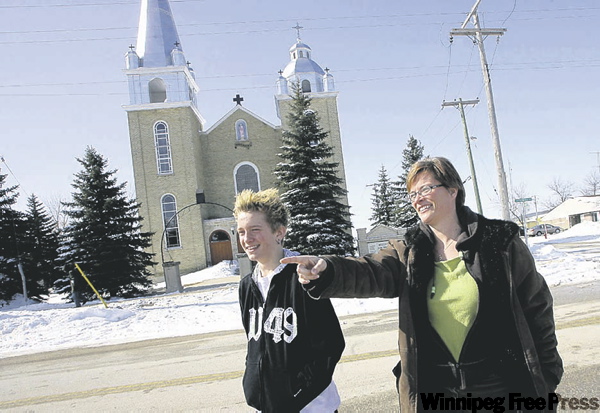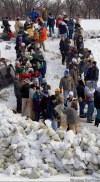South of ‘Peg, residents take flood watch in stride
Advertisement
Read this article for free:
or
Already have an account? Log in here »
To continue reading, please subscribe:
Monthly Digital Subscription
$1 per week for 24 weeks*
- Enjoy unlimited reading on winnipegfreepress.com
- Read the E-Edition, our digital replica newspaper
- Access News Break, our award-winning app
- Play interactive puzzles
*Billed as $4.00 plus GST every four weeks. After 24 weeks, price increases to the regular rate of $19.00 plus GST every four weeks. Offer available to new and qualified returning subscribers only. Cancel any time.
Monthly Digital Subscription
$4.75/week*
- Enjoy unlimited reading on winnipegfreepress.com
- Read the E-Edition, our digital replica newspaper
- Access News Break, our award-winning app
- Play interactive puzzles
*Billed as $19 plus GST every four weeks. Cancel any time.
To continue reading, please subscribe:
Add Winnipeg Free Press access to your Brandon Sun subscription for only
$1 for the first 4 weeks*
*$1 will be added to your next bill. After your 4 weeks access is complete your rate will increase by $0.00 a X percent off the regular rate.
Read unlimited articles for free today:
or
Already have an account? Log in here »
Hey there, time traveller!
This article was published 28/03/2009 (6017 days ago), so information in it may no longer be current.
STE. AGATHE — Residents in the Red River Valley are cautiously optimistic that they are better protected now than then they were during the 1997 Flood of the Century.
However, the big unknown remains the weather and what could happen if there’s more rain and snow in the next three weeks along with the threat from unpredictable ice jams that trigger flash flooding.
"I would not count on Mother Nature being predictable," said Norbert Schwabl, who lost his house in 1997 when the town was suddenly deluged by overland flooding.

The area is not protected by the floodway that rings Winnipeg.
"Ste. Agathe has never been the same."
Michelle Courcelles, who also lost her home in 1997, said Friday the valley is in a much better position to hold back what’s coming up the Red this spring.
"My panic button isn’t flashing yet," she said, as she and her 13-year-old son Franky showed where their home once stood. "We’re better prepared. A lot of changes have been made."
Those changes dot the valley as homes, farms and communities either have been raised on earth mounds or ringed by earth dikes.
Morris Reeve Herm Martens said 95 per cent of homes are protected to two feet above the 1997 flood level. The remaining homes are protected to one foot above the 1997 flood level.
Martens said Manitoban shouldn’t panic about what’s happening in Fargo.
"We are being very careful in comparing this year to 1997," he said. "We don’t think it will be like it at all."
Ritchot Mayor Bob Stefaniuk, said people are anxious about this spring because 1997 is still fresh in many memories.
Ste. Agathe was hit by overland flooding from the west, not from the Red bursting through dikes on the east. Most homes in the tiny town were flooded, including the church.
But Stefaniuk said residents should not be worried.
"I think it won’t be an issue," he said of flooding this year and possible evacuation. "It’s not even contemplated."
Premier Gary Doer and senior Manitoba MP Vic Toews toured the area Friday to show how diking and flood planning, along with the expanded floodway, has reduced the chance of property being damaged by flooding.
"We feel we can handle all the water," Doer said.
"It’s the ice that can jam. Ice is crucial. The issue is what can ice do with that water."
Toews added the Armed Forces is on standby should the flood threat increase but it’s unlikely they’ll be needed as they were in 1997.
That’s because the chance of a 1997-level flood is less than 10 per cent.

Overland flooding caused by frozen culverts is a threat south of Winnipeg.
"With this cold weather, everything seems to be sealed up a bit," Bob Koop, councillor in the RM of Tache said.
The municipality includes the communities of Lorette and Landmark, which have been battling overland flooding.
"The thing that still worries me is the 150 frozen culverts we have right now and if it melts quick."
Like many neighbouring municipalities, Tache officials are working to thaw and clear ice-clogged culverts to alleviate the risk of flooding.
bruce.owen@freepress.mb.ca
Sandbagging tips
Given Manitoba’s annual spring flooding, you’d think we’d have the art of sangbagging down pat. Not so, says University of Manitoba civil engineering Prof. James Blatz. Sandbags seem like such a low-tech way of fighting floods, but they’re cheap, fast and they work in the short term. Here are a few things Blatz has learned to make them work even better:
Sandbags shrink after the flood waters arrive, because the sand inside gets wet and compacted. That’s common sense, but no one has measured how much a dike might shrink. Turns out, quite a bit. An eight-foot dike shrinks by about eight inches. The city and the province have started taking that into account when marking dike elevations. And, the general rule of "1997 flood levels plus two feet" works well.
Waves weaken sandbag dikes, especially when the bags are made of woven polypropylene. Sand particles are smaller than the weave and get sucked out into the water. Preliminary experiments suggests another type of bag works better, and Blatz has alerted the city and province to those results.
Don’t start sandbagging on snow. It makes the dike less stable. Instead, it works better to dig a shallow trench and nestle the first layer of bags right in the dirt, which kind of locks them in place. Watch a video: The city has videos on how to build a sandbag dike: winnipeg.ca/emergWeb/Flood/BuildingADike.stm
— Mary Agnes Welch







